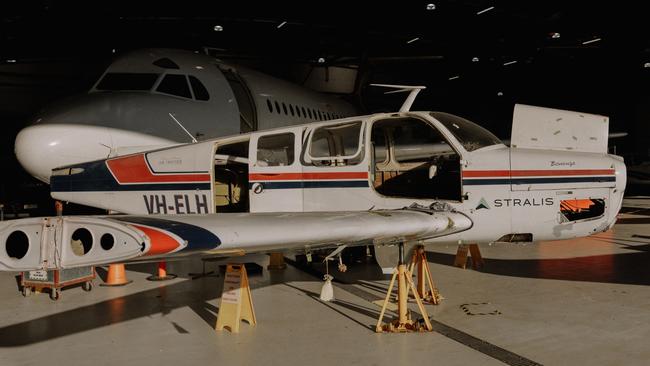Brisbane’s Stralis Aircraft leads Australia’s first hydrogen-powered flight
Inside a Brisbane hangar, an experiment to retrofit a six-seater plane called Clyde with hydrogen-electric propulsion technology could hold the secret to sustainable travel.

Dr Emma Whittlesea has a PhD in low-carbon tourism, a career built on advancing environmental sustainability and a dream of enabling guilt-free travel for a world that, more than ever, wants the freedom to navigate the globe without impacting the planet.
Her job as head of partnerships at Brisbane-based Stralis Aircraft puts Whittlesea in the box seat to help develop emissions-free aviation using hydrogen-electric propulsion to power aircraft.

Stralis was set up by Bob Criner and Stuart Johnstone three years ago to design and build a “green” engine that can be retrofitted into existing aircraft and integrated into new aircraft designs.
The company is backed by a range of investors and supported by the federal government’s Emerging Aviation Technology Partnerships Program.
Working towards sustainable travel
At its headquarters at Brisbane airport, the Stralis team is working on a technology demonstrator aircraft – a six-seater Beechcraft Bonanza A36 with a 500km range – and its application to a 15-seater Beechcraft 1900D that will be flown by Skytrans between Brisbane and Gladstone.
The goal is to integrate hydrogen-electric propulsion into a 50-seater aircraft with a possible 3000km range.

The company is part of a global clean-tech research and development effort, alongside companies such as Airbus and ZeroAvia, to use green hydrogen to power a new generation of aircraft. Whittlesea says retrofitting planes “reduces certification risk, accelerates adoption timelines, and helps prevent stranded assets”.
She adds: “Aside from being cleaner, we believe that the technology will be up to 50 per cent cheaper to operate, and quieter. Hydrogen is produced from water through electrolysis – which is green if you’re using renewable energy to power that process. When green hydrogen is used in the hydrogen-electric powertrain system, it only generates water as a by-product.”
Hydrogen technology
Hydrogen-electric propulsion, unlike jet propulsion, creates zero carbon dioxide, NOx, sulphates, hydrocarbons, lead, and particulates (soot).
The Stralis system is based on new high-temperature fuel cell technology that is six times lighter than existing fuel cells.
The patent-pending technology could also be used in other applications, such as rail, marine, heavy haulage, mining and remote microgrids.

This is an article from The List: 100 Top Energy Players 2024, which is announced in full on November 22.
Whittlesea studied environmental science at the University of Plymouth in the UK before doing a PhD as a mature-aged student while working in a full-time job. She came to Australia in 2013 and has worked at Griffith University and with the Queensland government in climate transition roles, joining Stralis last year.
Through her PhD and work in sustainable tourism, she realised, “There was a lot of work to do to make travel and aviation more sustainable and less impactful.”
She is well aware the rise of cheap mass tourism and travel is a challenge.

“We don’t have readily available low-emission solutions for aviation at the moment, and yet we still have a strong growth trajectory, which increases the scale of the challenge,” she says. “We’re shifting to renewables in some sectors, like the energy sector, but the transport sector is quite far behind. If you look at the investment going into new and emerging clean aviation technology in Europe and in the United States, in comparison to Australia, it’s on a far different scale.”
She says the federal government’s recent aviation white paper, Towards 2050 – which identifies decarbonisation of the sector among its priorities and recognises the role of electric and hydrogen-powered flight – provides “a big opportunity for Australia, in terms of creating the policy framework to help activate and finance change”.
Part of her work in partnerships has been supporting the establishment and evolution of the Hydrogen Flight Alliance, which brings together key stakeholders to advance the hydrogen-electric flight ecosystem in Australia.







To join the conversation, please log in. Don't have an account? Register
Join the conversation, you are commenting as Logout